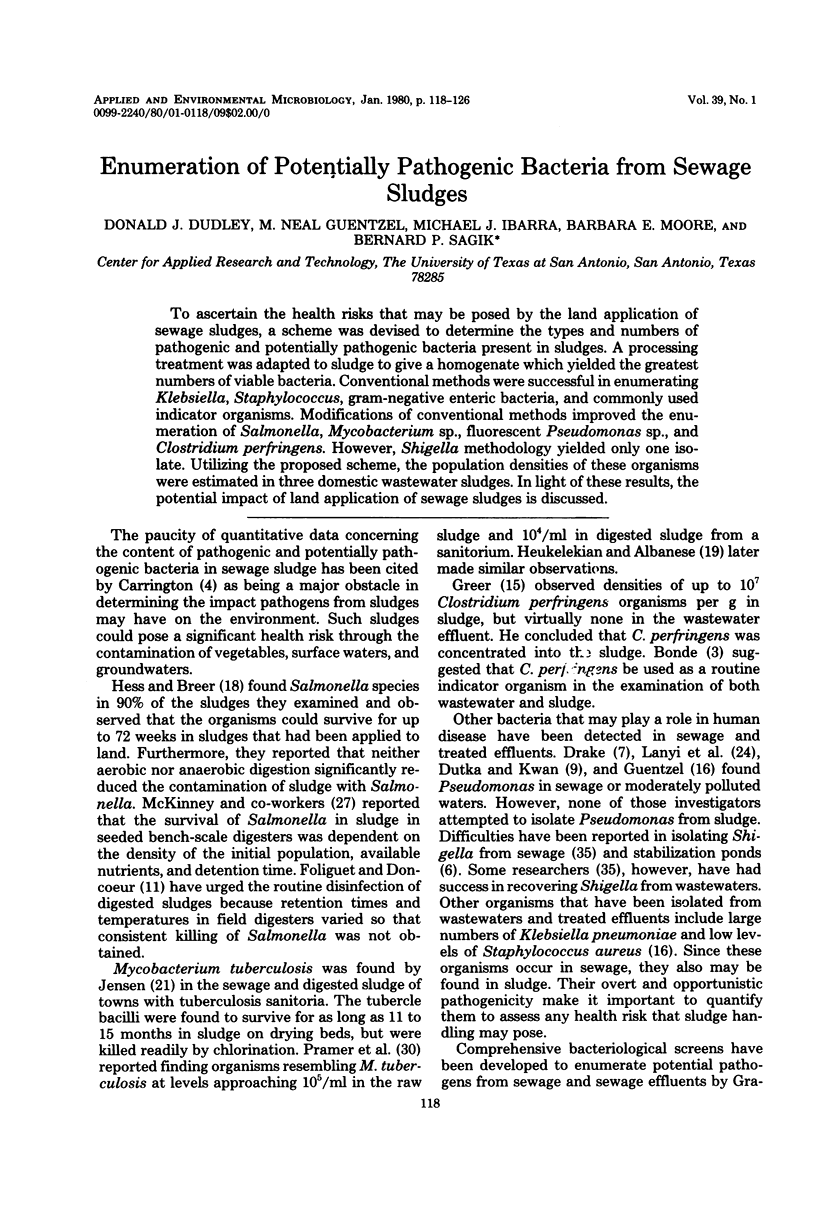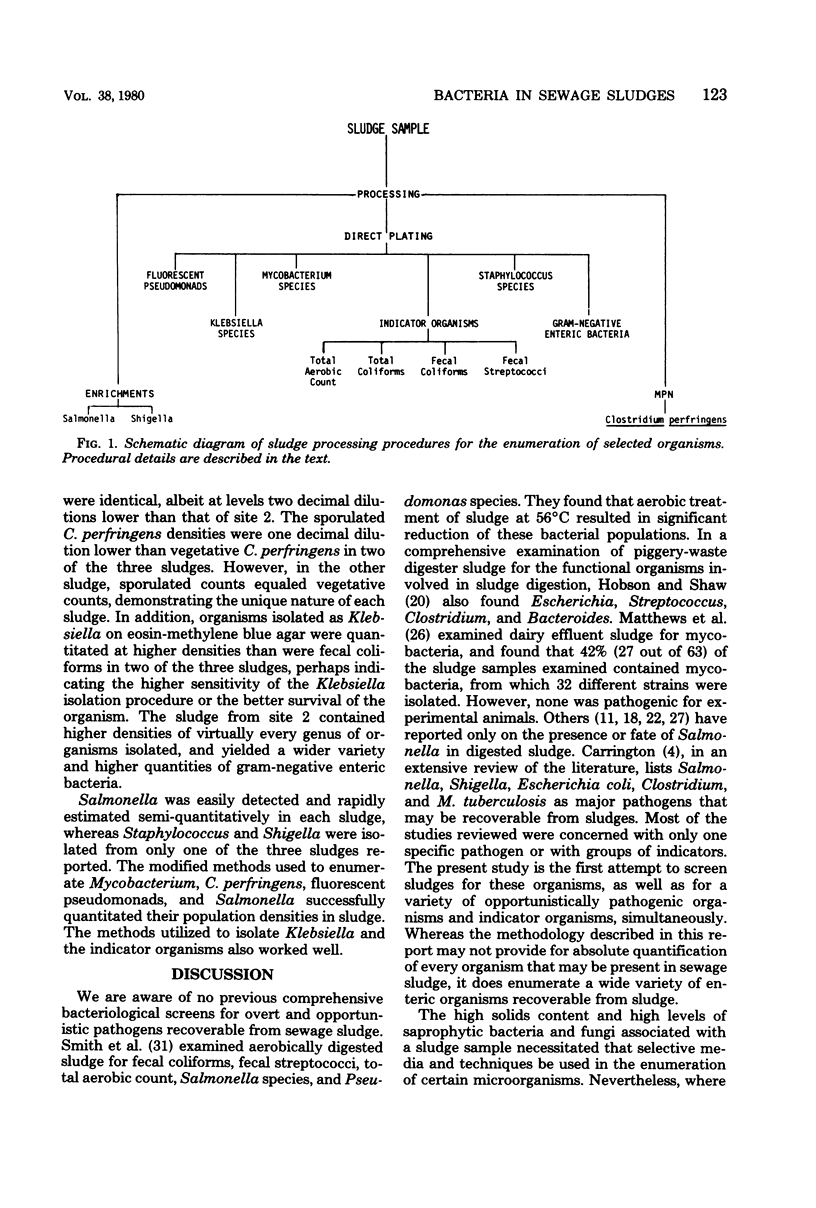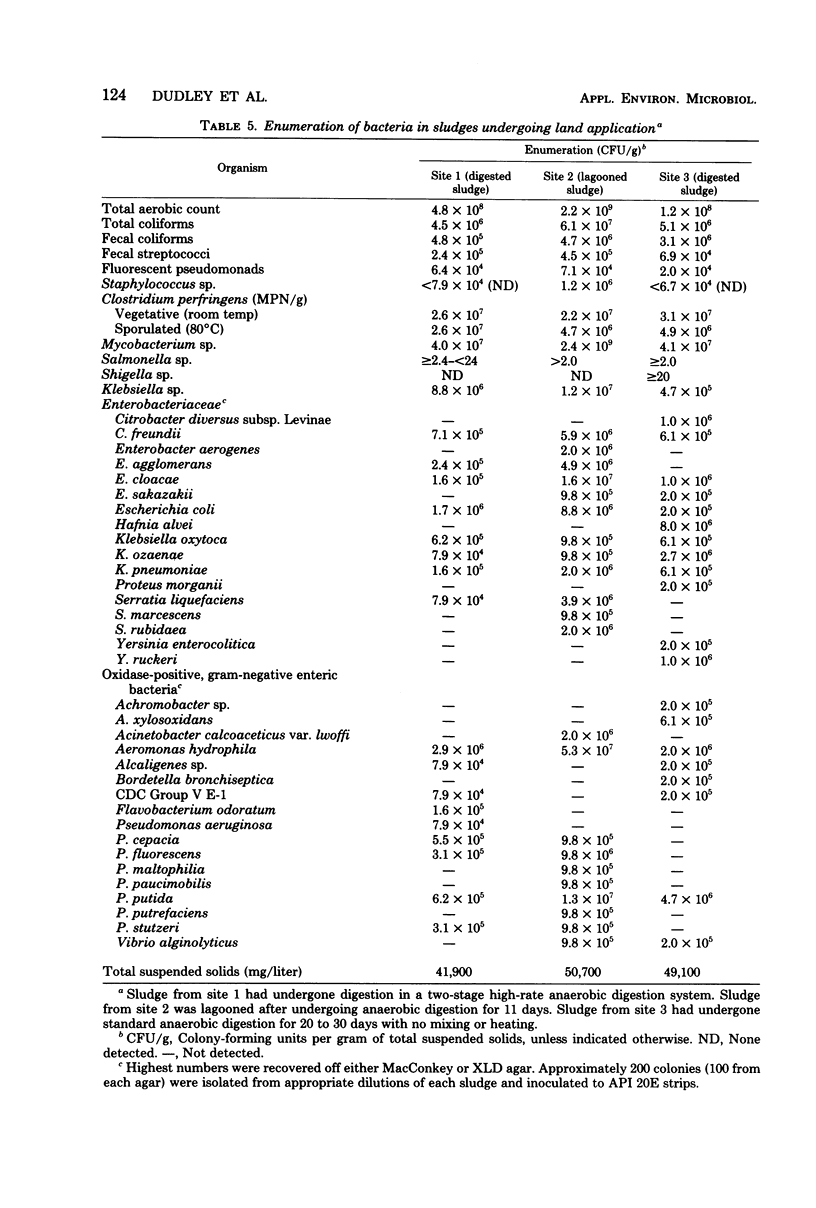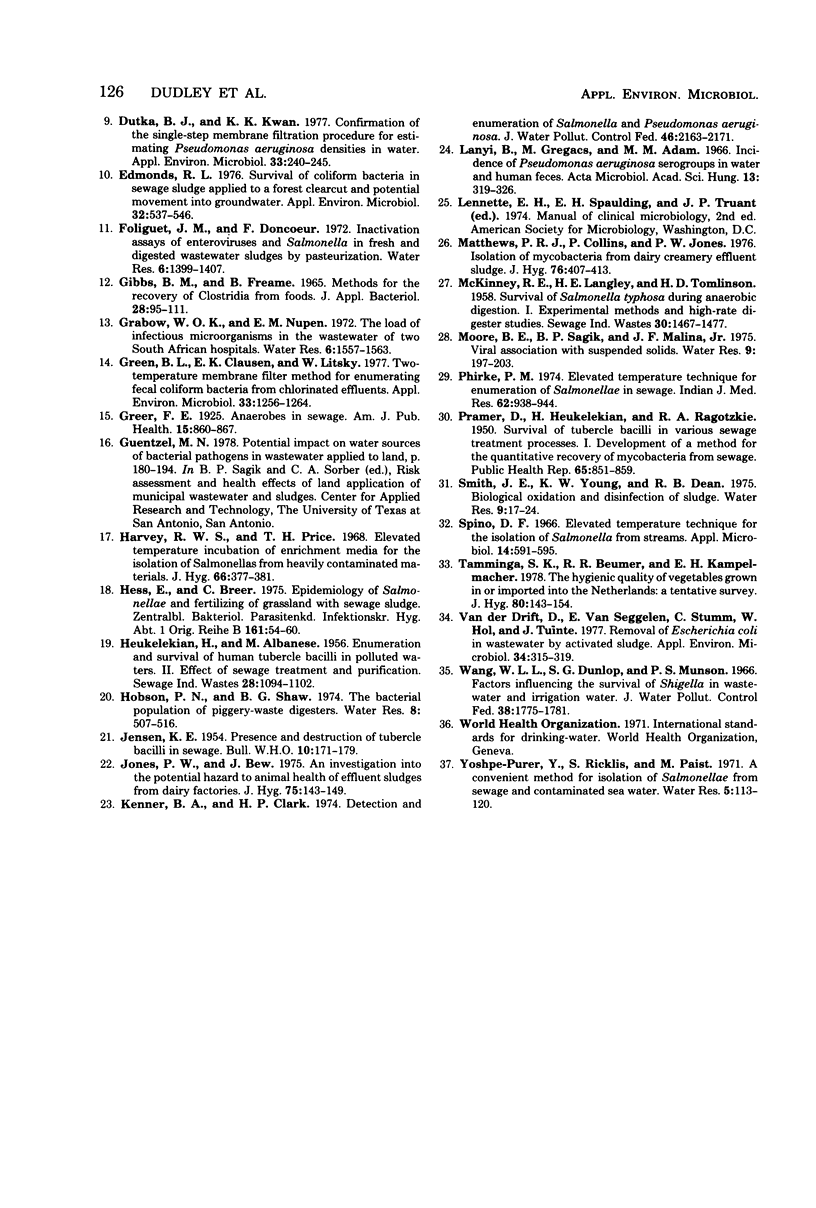Abstract
To ascertain the health risks that may be posed by the land application of sewage sludges, a scheme was devised to determine the types and numbers of pathogenic and potentially pathogenic bacteria present in sludges. A processing treatment was adapted to sludge to give a homogenate which yielded the greatest numbers of viable bacteria. Conventional methods were successful in enumerating Klebsiella, Staphylococcus, gram-negative enteric bacteria, and commonly used indicator organisms. Modifications of conventional methods improved the enumeration of Salmonella, Mycobacterium sp., fluorescent Pseudomonas sp., and Clostridium perfringens. However, Shigella methodology yielded only one isolate. Utilizing the proposed scheme, the population densities of these organisms were estimated in three domestic wastewater sludges. In light of these results, the potential impact of land application of sewage sludges is discussed.
Full text
PDF








Selected References
These references are in PubMed. This may not be the complete list of references from this article.
- ANGELOTTI R., HALL H. E., FOTER M. J., LEWIS K. H. Quantitation of Clostridium perfringens in foods. Appl Microbiol. 1962 May;10:193–199. doi: 10.1128/am.10.3.193-199.1962. [DOI] [PMC free article] [PubMed] [Google Scholar]
- Bonde G. J. Bacteriological methods for estimation of water pollution. Health Lab Sci. 1966 Apr;3(2):124–128. [PubMed] [Google Scholar]
- Cheng C. M., Boyle W. C., Goepfert J. M. Rapid quantitative method for Salmonella detection in polluted waters. Appl Microbiol. 1971 Apr;21(4):662–667. doi: 10.1128/am.21.4.662-667.1971. [DOI] [PMC free article] [PubMed] [Google Scholar]
- Cody R. M., Tischer R. G. Isolation and frequency of occurrence of Salmonella and Shigella in stabilization ponds. J Water Pollut Control Fed. 1965 Oct;37(10):1399–1403. [PubMed] [Google Scholar]
- Drake C. H. Evaluation of culture media for the isolation and enumeration of Pseudomonas aeruginosa. Health Lab Sci. 1966 Jan;3(1):10–19. [PubMed] [Google Scholar]
- Dutka B. J., Bell J. B. Isolation of salmonella from moderately polluted waters. J Water Pollut Control Fed. 1973 Feb;45(2):316–324. [PubMed] [Google Scholar]
- Dutka B. J., Kwan K. K. Confirmation of the single-step membrane filtration procedure for estimating Pseudomonas aeruginosa densities in water. Appl Environ Microbiol. 1977 Feb;33(2):240–245. doi: 10.1128/aem.33.2.240-245.1977. [DOI] [PMC free article] [PubMed] [Google Scholar]
- Edmonds R. L. Survival of coliform bacteria in sewage sludge applied to a forest clearcut and potential movement into groundwater. Appl Environ Microbiol. 1976 Oct;32(4):537–546. doi: 10.1128/aem.32.4.537-546.1976. [DOI] [PMC free article] [PubMed] [Google Scholar]
- Green B. L., Clausen E. M., Litsky W. Two-temperature membrane filter method for enumerating fecal coliform bacteria from chlorinated effluents. Appl Environ Microbiol. 1977 Jun;33(6):1259–1264. doi: 10.1128/aem.33.6.1259-1264.1977. [DOI] [PMC free article] [PubMed] [Google Scholar]
- Greer F. E. ANAEROBES IN SEWAGE. Am J Public Health (N Y) 1925 Oct;15(10):860–867. doi: 10.2105/ajph.15.10.860. [DOI] [PMC free article] [PubMed] [Google Scholar]
- Harvey R. W., Price T. H. Elevated temperature incubation of enrichment media for the isolation of salmonellas from heavily contaminated materials. J Hyg (Lond) 1968 Sep;66(3):377–381. doi: 10.1017/s0022172400041243. [DOI] [PMC free article] [PubMed] [Google Scholar]
- Hess E., Breer C. Salmonellenepidemiologie und Grünlanddüngung mit Klärschlamm. Zentralbl Bakteriol Orig B. 1975 Sep;161(1):54–60. [PubMed] [Google Scholar]
- JENSEN K. E. Presence and destruction of tubercle bacilli in sewage. Bull World Health Organ. 1954;10(2):171–179. [PMC free article] [PubMed] [Google Scholar]
- Jones P. W., Bew J., Gammack D. B. An investigation into the potential hazard to animal health of effluent sludge from dairy factories. J Hyg (Lond) 1975 Aug;75(1):143–149. doi: 10.1017/s0022172400047161. [DOI] [PMC free article] [PubMed] [Google Scholar]
- Kenner B. A., Clark H. P. Detection and enumeration of salmonella and pseudomonas aeruginosa. J Water Pollut Control Fed. 1974 Sep;46(9):2163–2171. [PubMed] [Google Scholar]
- Lányi B., Gregács M., Adám M. M. Incidence of Pseudomonas aeruginosa serogroups in water and human faeces. Acta Microbiol Acad Sci Hung. 1966;13(4):319–326. [PubMed] [Google Scholar]
- Matthews P. R., Collins P., Jones P. W. Isolation of mycobacteria from dairy creamery effluent sludge. J Hyg (Lond) 1976 Jun;76(3):407–413. doi: 10.1017/s0022172400055339. [DOI] [PMC free article] [PubMed] [Google Scholar]
- PRAMER D., HEUKELEKIAN H., RAGOTZKIE R. A. Survival of tubercle bacilli in various sewage treatment processes; development of a method for the quantitative recovery of Mycobacteria from sewage. Public Health Rep. 1950 Jul 7;65(27):851–859. [PMC free article] [PubMed] [Google Scholar]
- Phirke P. M. Elevated temperature technique for enumeration of salmonellae in sewage. Indian J Med Res. 1974 Jun;62(6):938–944. [PubMed] [Google Scholar]
- Spino D. F. Elevated-temperature technique for the isolation of Salmonella from streams. Appl Microbiol. 1966 Jul;14(4):591–596. doi: 10.1128/am.14.4.591-596.1966. [DOI] [PMC free article] [PubMed] [Google Scholar]
- Tamminga S. K., Beumer R. R., Kampelmacher E. H. The hygienic quality of vegetables grown in or imported into the Netherlands: a tentative survey. J Hyg (Lond) 1978 Feb;80(1):143–154. doi: 10.1017/s002217240005347x. [DOI] [PMC free article] [PubMed] [Google Scholar]
- Wang W. L., Dunlop S. G., Munson P. S. Factors influencing the survival of Shigella in wastewater and irrigation water. J Water Pollut Control Fed. 1966 Nov;38(11):1775–1781. [PubMed] [Google Scholar]
- van der Drift C., van Seggelen E., Stumm C., Hol W., Tuinte J. Removal of Escherichia coli in wastewater by activated sludge. Appl Environ Microbiol. 1977 Sep;34(3):315–319. doi: 10.1128/aem.34.3.315-319.1977. [DOI] [PMC free article] [PubMed] [Google Scholar]


